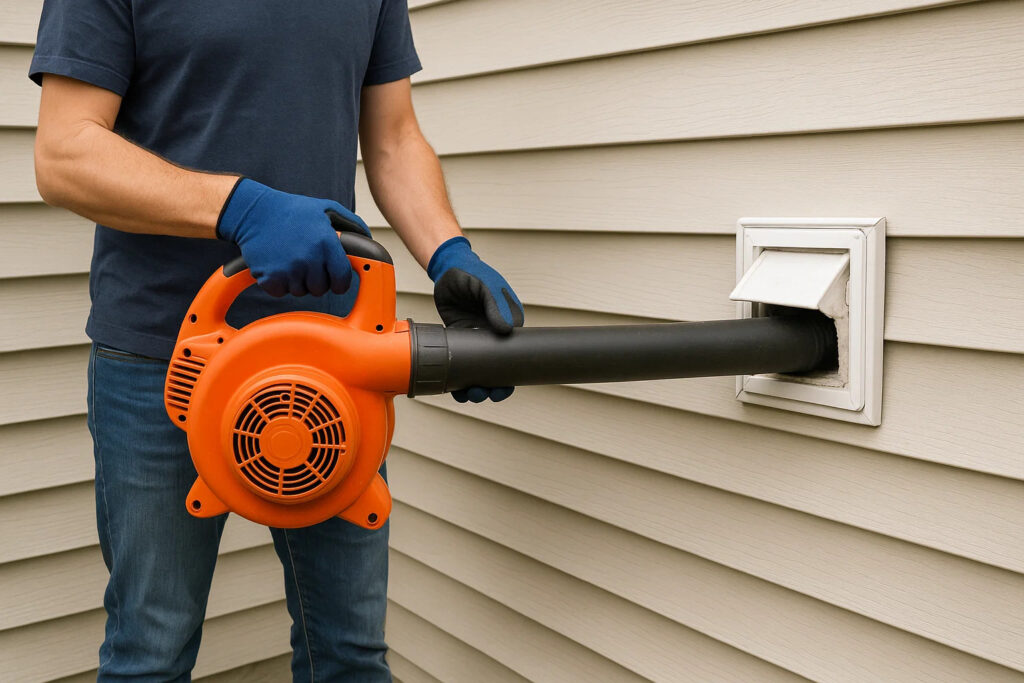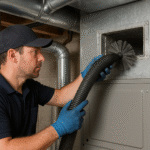When laundry suddenly takes longer to dry or the dryer feels hotter than usual, it often signals hidden lint buildup in the vent system. Ignoring this not only drives up energy bills but also raises fire risks. While professionals can handle the task, a more practical option exists Cleaning Dryer Vent With Leaf Blower.
Why It Matters:
Every time clothes tumble inside the dryer, bits of lint and dust pass through the vent system. Over months, these particles cling to duct walls, narrowing the airflow. Reduced circulation forces the dryer to work harder, wasting electricity and straining its parts. More importantly, a clogged vent is one of the leading causes of home dryer-related fires. Taking the time to maintain the vent ensures safer laundry routines and extends appliance life.
Common Problems:
Blocked dryer vents don’t just inconvenience you; they create layered issues. A primary concern is overheating, which can warp internal components or shorten the dryer’s lifespan. Clogged vents may also trap heat and moisture, encouraging mold growth around walls or the exhaust exit. If airflow becomes severely obstructed, clothes may come out damp or develop musty odors. For homeowners searching the best way to clean dryer vent without a kit, a leaf blower often emerges as the easiest, fastest, and most budget-friendly tool. Other DIY approaches—like using a vacuum, flexible rods, or even homemade duct hacks—can work, but blowing lint out with a leaf blower clears the line more thoroughly.
Key Benefits:
Using a leaf blower has practical advantages. It saves you from having to avoid professional dryer vent cleaning costs while still achieving impressive results. Unlike wet vacuums or standard handheld cleaners, a high-powered leaf blower pushes lint and dust straight through the pipe and out the exterior vent. This method requires little setup, takes minutes to complete, and avoids recurring service fees. Plus, the tool you already own for yard work transforms into a handy household maintenance helper.
The Role of Dryer Vent Blockage Removal DIY:
Yes, dryer vent blockage removal DIY is entirely possible with some caution. Start by disconnecting the dryer from its wall connection. Attach the blower nozzle firmly to the vent opening. Once secured, run the leaf blower for short bursts. Step outside to check if lint clouds release from the vent hood. If air passes freely and no clogs remain, your dryer is safe to use again. Keep in mind, though, that very long ducts or complicated vent pathways may require professional tools.
A Professional Quote:
“Routine dryer vent cleaning is more than just about efficiency—it’s about safety. While DIY methods such as leaf blowers are effective for straight ducts, homeowners should still schedule inspections every couple of years to prevent hidden hazards.”
says Michael Grant, a certified appliance repair technician. His advice underscores that while DIY methods save money, occasional professional checks ensure peace of mind.
Cost Breakdown:
| Option | Average Cost | Notes |
|---|---|---|
| Professional Dryer Vent Cleaning | $100–$200 | Comprehensive service; includes inspection and blockage removal |
| DIY With Leaf Blower | $0–$60 | Free if you already own a blower; $40–$60 if purchasing a new unit |
| Dryer Vent Cleaning Kits | $20–$40 | Flexible rods and brushes; effective but less powerful than blowers |
| DIY With Wet/Dry Vacuum | $0–$50 | Useful for short vents; may struggle with deeper clogs |
Disclaimer: Prices are estimates and vary by region, equipment brand, and vent condition.
Key Features:
- Fast lint removal in under 15 minutes.
- No special kit required—just a common yard tool.
- Avoid professional dryer vent cleaning costs without sacrificing effectiveness.
- Clears long ducts more efficiently than handheld vacuums.
- Blows out clogs completely instead of pulling them partially loose.
- Doubles as a regular maintenance method for ongoing lint prevention.
Safety:
Safety must come first. Always unplug the dryer before starting. Ensure the vent hose is free of cracks, as weak sections could blow lint into walls instead of outside. Never use a gas-powered blower indoors due to carbon monoxide risks. Wear goggles dryer airflow improvement and a dust mask when standing near the exterior vent since flying lint can cause irritation. Finally, limit blower use to short bursts to avoid damaging seals or vent joints.
Emergency Services:
If your vent remains obstructed after several attempts, don’t force more air through the pipe. This could jam debris deeper or harm duct seams. Instead, call a licensed technician for emergency cleaning. Professionals use rotary brushes, industrial vacuums, and cameras to detect hidden clogs. In urgent cases where dryers overheat or emit burning odors, disconnect power immediately and seek same-day service.
FAQs:
How do I know if my dryer vent is clogged?
Signs include longer drying times, overheating, musty-smelling clothes, or lint buildup around the vent cover.
Can I use a vacuum instead of a leaf blower?
Yes, but a vacuum may not have enough force to push clogs out of long ducts.
Is blowing lint outside messy?
Yes, lint will scatter near the vent exit. Place a tarp or bag beneath to catch debris.
Do I need a special kit for this method?
No, the leaf blower replaces the need for kits, rods, or brushes.
Can this method damage dryer vents?
Not if used carefully. Stick to short bursts of air instead of continuous pressure.
How often should vents be cleaned?
At least once per year, or more often for large households using the dryer daily.
What happens if vents stay clogged?
Dryers overheat, clothes remain damp, ducts may develop mold, and fire risks rise.
Can wet lint block airflow?
Yes, moisture makes lint stickier, creating tougher clogs inside ducts.
Are homemade vent cleaning hacks safe?
Some are effective, but always avoid flammable cleaners or sharp tools inside ducts.
Is hiring a handyman better than DIY?
Handymen can handle minor unclogging, but professionals with specialized tools are best for complex ducts.
Conclusion:
With the right steps, a leaf blower becomes more than a yard tool—it’s a cost-saving hack that restores dryer performance and reduces fire risk. From fast lint removal to ongoing upkeep, this method offers an effective way to maintain your laundry system without heavy expenses. If you’re ready to improve safety, cut energy bills, and avoid professional dryer vent cleaning costs, now is the time to give it a try. Take action today: grab your blower, clear your ducts, and keep your home protected.
Read More: Dryer Vent Cleaning San Antonio


